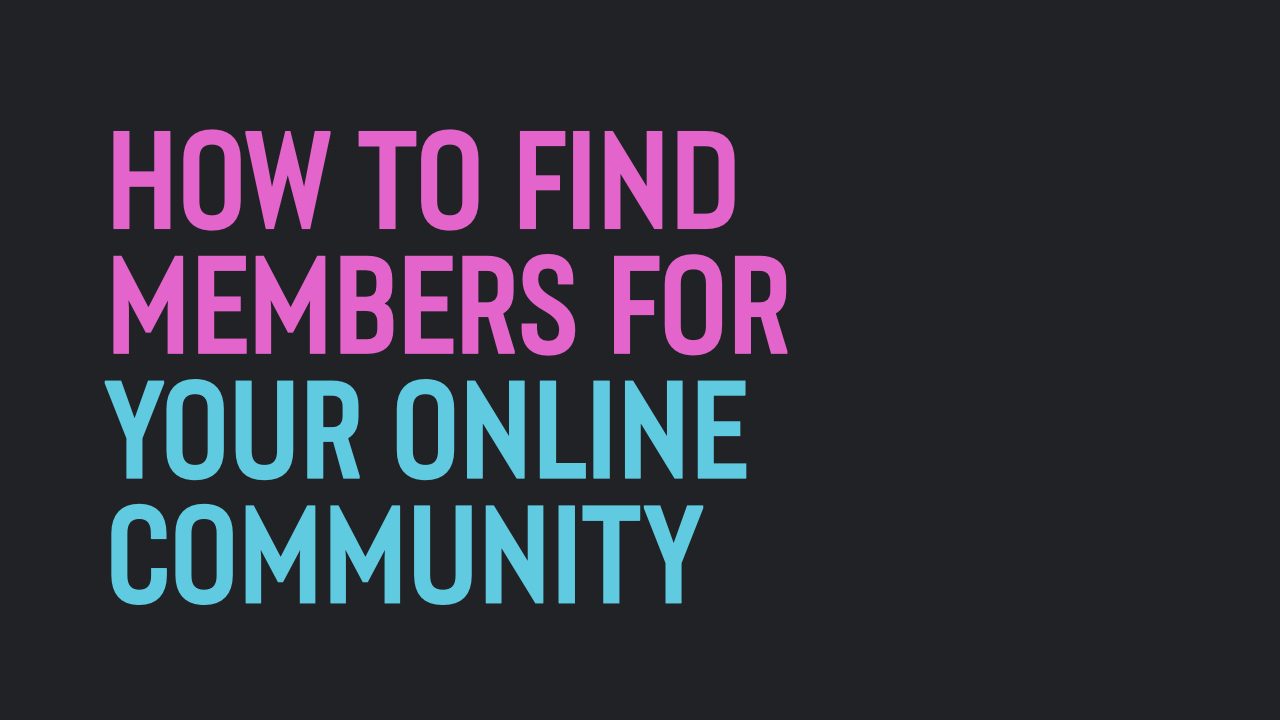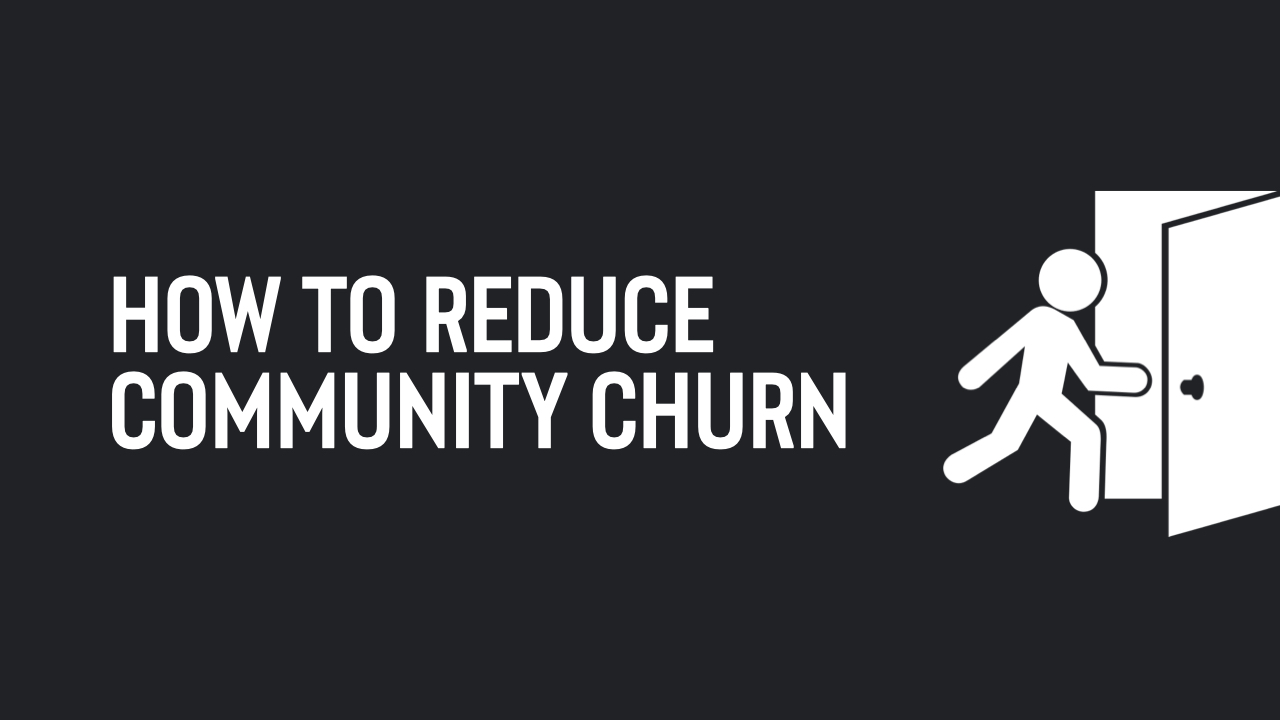
Are you looking to find members for your online community?
Recently, inside Learn.Community, I asked our members what their biggest fears around community building were. One of our members, Shauna, shared a sentiment that was echoed by many:
“I haven’t started my Community yet so my biggest would be getting enough people to sign up monthly.”
Whether you’re launching your first community, or trying to scale an existing community, member acquisition is hard! However, if you want to succeed, you have to figure out how to actually find members for your online community.
I often work with community builders who plug hypothetical numbers into a growth projection
“If I get 50 members per month, in 12 months I’ll have 600 members!”
What they don’t realise, is that getting even one person to sign up for your free community is impressive, let alone convincing a stranger to give you money each month to participate in your paid community.
6 steps to find members for your online community
Today, I wanted to share 6 actionable steps that will help you to find members for your online community:
1: Set goals, understand your numbers
Before setting targets for member acquisition, you need to understand where you’re going.
What is the end goal?
If you’re looking to run a paid community, I’d advise starting with your end revenue goal. Then reverse engineer from there.

For example, let’s say you wanted to be earning $5000 from your online community in 12 months time. You plan on charging $49 per month for membership, and anticipate a 10% churn rate (the % of members who cancel each month).
In this case, you’d need 15 members each month, paying $49, to hit your target of $5000 monthly revenue in 12 months.
This gives far more clarity than just aiming for ‘as many members as possible’, which is a muddy goal.
You can even break it down into weekly sprint goals. In the above example, you should aim for 4 members per week.
Then you can easily adjust your projections as you go, based on what’s actually happening. Remember, projections are a guide, they’re rarely exactly accurate.
The same approach can apply to free communities, but simply use number of members as your top level goal.
That being said, please please remember – the QUALITY of your members is much more important than the quantity.
2: Nail your value proposition
Once you’ve set your member acquisition targets, you need to make sure your value proposition is strong.
What is the value you’re promising members?
If you don’t have a clear, compelling answer to that question, you will struggle to attract members.
Think of it this way – imagine two food trucks. One is serving amazingly tasty street food. The other is serving rotten, ugly food, that no person in their right mind would consume.
The point is, if your core offering isn’t good, no amount of marketing or effort on your part will convince people to buy into it.
People tend to over-think the value they’re offering.
Often times they’ll lump on as many bells and whistles as possible, to try and artificially inflate how valuable their community appears. Typically, this has the opposite effect.
Rather than listing dozens of features and benefits for your community, focus on just one: transformation.

Your community should help your members get from point A to point B. That’s it. Everything else is supportive to that.
To give you an example, at Learn.Community, we offer two transformations:
Having no online community > Launching your online community
Running an online community that is struggling > Running an online community that is thriving
If you’re reading this, those transformations should be enough for you to self identify and buy into that transformation. I don’t need to tell you the details of every piece of content, every forum post, every workshop, for you to at least initially resonate with that transformation and want to achieve it.
Where I see community builders struggling to find members is where their value proposition is either weak or unclear.
If my value proposition was ‘Umm… help community members get better in what they’re doing, and ultimately fulfil their growth potential and dreams’, you’d be right to think ‘What!? That’s super fluffy, what does that even mean?’. But if you’re someone who’s looking to launch their first community, and needing a bit of support, my current value prop should be far more compelling.
3: Validate your value proposition
Once you’re feeling happy with your value proposition, you need to go and test it on people. Don’t just assume it’s awesome and that people will be lining up to join your community.
There are many ways to validate a concept, but my favourite is good old-fashioned one-on-one conversations.

Just go talk to as many people in your network as possible who you think may be interested in a community like this, and ask for their honest feedback on your value proposition.
Some tips for this:
- Ask them to be brutally honest
- See if your value proposition is clear to them
- Ask them to articulate back to you what they think it means
- See how much it resonates with them personally
- Find out if they think a community like that would be a good fit for them
- Determine if they would be willing to pay for something like that in future
- See if there’s anything they don’t like about it
- Ask which bits stuck out to them the most
- Don’t just listen to their words – pay attention to body language. Do they get visibly excited and enthusiastic as you’re speaking, or do they look bored or disinterested?
- Take notes throughout!
Use this time to be a sponge. Soak up as many insights from these people as possible. Don’t be afraid to adjust, clarify or pivot your value proposition if it’s not hitting the mark.
4: Leverage your immediate network
Once your community is ready for launch, with a super strong, validated value proposition, it’s time to find some members!
I’m always a fan of building a waitlist in advance of launch. This is way less risky than just opening the doors and hoping people sign up.
Tip: If you’re running a paid community, have a question as part of your waitlist application where people must choose a pricing plan. This commitment weeds out the freebie-seekers, and ensures that people can self-identify as potential paying members.
I would always recommend starting with your immediate network when sourcing early members.

Hopefully in your validation exercise you spoke with at least dozens of people.
This is the time to go back to those people who were interested and say:
“Hey! Remember that community you were excited about? Well it’s now ready, and I took all of your feedback and incorporated it into the community, to make it as valuable as possible. If you’re still interested in being a founding member, you can apply here (link).”
5: Leverage your audience
If you have any kind of audience (blog, social media etc…) then this is the time to leverage them.

Post content which directly calls out your community.
In my case, I’ll use Instagram carousels, wherein the final slide of the carousel post is a call to action to DM me if you’re interested in joining my community. You can see this below:

I’ll also write articles like this one, share in stories and post regularly on Twitter.
The best content is content that links directly back to your value proposition. Always keep that in mind. Think ‘will this content appeal to people who are seeking the transformation my community offers?’.
6: Leverage other people’s audiences
I’ve spoken at length about this, but this strategy is known as distribution. It’s highly effective, but takes real work and planning.
Think of it this way – your own audience may be limited, and you’ll quickly exhaust it. It won’t provide you with an endless supply of new members.
However, there are tons of existing audiences out there, filled with potential members for your community.
You just have to work to get in front of them and provide as much value as possible – followed by a CTA (call to action) to check out your community.

Recently, we launched our November cohort for Learn.Community, and thankfully exceeded all of our target numbers by nearly 50%. This was largely down to 2 weeks of intense distribution work, which included:
- 2 guest newsletters for friends, where I taught community strategies
- A guest post for Chris Do on Instagram
- 2 speaking gigs, inside membership communities
- Sharing a case-study of my community on Circle (my favourite community platform right now)
This point is, I never would have hit our member growth goals without this burst of distribution work.
The trick is to make this consistent!
The best community builders and marketers I know have a jam-packed calendar, where they’re regularly and intentionally bringing value to other audiences than their own.
This is something I’m currently working hard on building. My aim is to have one piece of distribution content every single day. Imagine getting in front of 30 new audiences each month! That will have a huge impact on our own member acquisition and awareness around our community.
It takes real work. Building relationships, creating workshops, carving out time for posts, guest articles etc… I doesn’t happen over night, but I promise you, it’s worth devoting a good chunk of effort towards each month.
Go forth and find members for your online community!
Community building can be incredibly rewarding and fulfilling, but it’s definitely not easy.
It’s likely that you will have weeks and months where you miss your member targets. Maybe they were wildly ambitious and you have to scrap them entirely. This is all normal.
If your growth targets aren’t working, then re-look at your value proposition, stay consistent with your content/distribution efforts and stay patient!
Growth doesn’t happen overnight. Many of the most successful communities took years to build.
You will fail at points, but you’ll learn a ton along the way.
Just realise – actually growing a community is infinitely harder than plugging some numbers into a projection.
I hope this guide on how to find members for your online community can serve you in your quest to build a thriving community of like-minded people.






